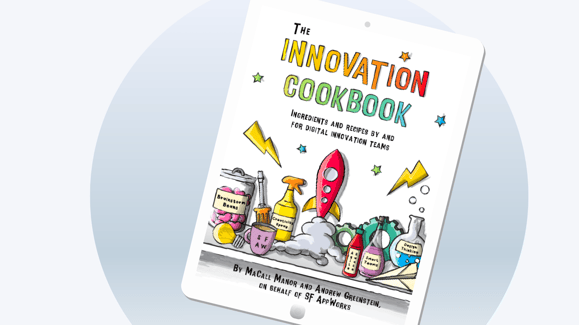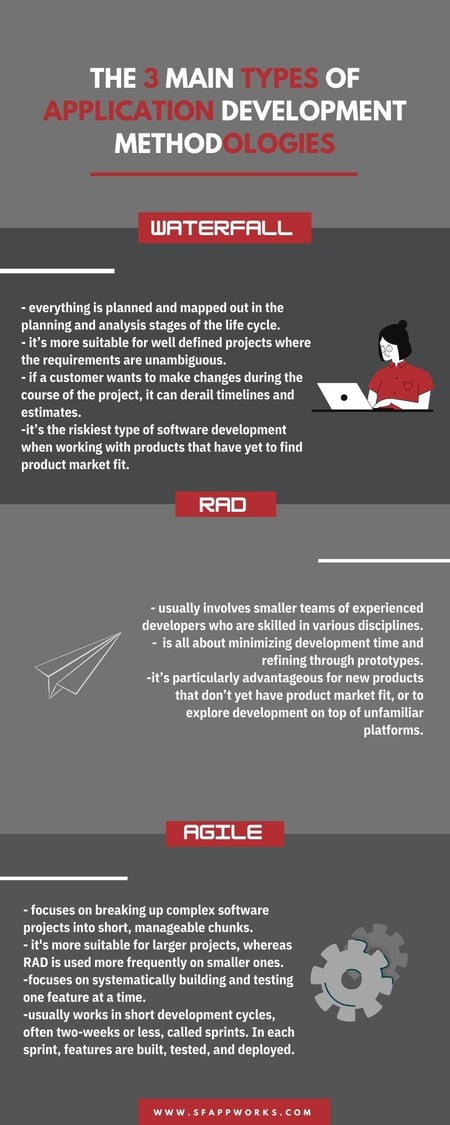Before diving into the types of application development methodologies, we're go through statistics. As of May, 2023, there are 6.92 billion smartphone users in the world. If your digital properties aren’t designed and built for smartphones, then you’re missing out on the preferred platform of close to half of the world population.
SF AppWorks can help bring your web and mobile apps to life, whether through native development, progressive web apps, or mobile-optimized websites. But understanding HOW to bring those apps to life is an entirely different topic, and the focus of this blog post.
Let’s dive into a few of the popular application development methodologies so we can understand and apply the best framework to our software development projects.
Before Choosing A Method of Application Development
Make sure you analyze all of these factors:
- team composition
- past experience of the project team with a particular methodology
- business goals
- product market fit
- how much change might be needed
- costs of delay
- feedback on the work done.
Considering these simple things can help teams get a bigger picture of the project they’re working on, no matter which type of software development methodology they ultimately choose to use.
Related: Things to Avoid to Ensure Successful App Development
The Software Development Life Cycle
The Software Development Life Cycle (“SDLC”) is a framework that development teams use to produce highly-adaptable software in a cost-effective way. It is made up of five key stages. There is the value and productivity analysis, the software planning stage, the design and development phase, finally the Launch and Learn (testing) phase, and finally the support phase. The software planning and development phases typically operate under one of three application development methodologies.
The development process should be continuously measured and improved, and that's where SDLC shines. It allows a fine-grain analysis of each stage of the process. This, in turn, minimizes the costs and the risks of bad consequences for the companies. SDLC is great at helping companies deliver software faster and meet or exceed their customers’ needs.
Get A Free Copy Of 'Actionable Steps To Digital Transformation & Real-World Examples On How Companies Made Significantly More Money Than What They Invested'
%20(1).png?width=340&name=digital%20transformation%20mockup%20(2)%20(1).png)
The Basic Stages of Software Development Lifecycle:
1. Analysis
Understanding what the software application is supposed to do and its requirements is crucial for the project's success. As teams get a clearer picture of the project’s nature and requirements, the chances they choose the application method that will generate the best results increase.
This phase includes the market analysis to understand the competition and the key features needed.
2. Planning
During this phase, project managers evaluate the terms of the project, from calculating labor and material costs, to creating a timetable with target goals, and defining the project’s teams and leadership structure. The Planning stage includes feedback from potential customers, developers, subject matter experts, and sales reps.
3. Design & prototyping
Once the requirements are specified, the design phase is the next step to make the digital product come to life. The design phase can be split into smaller stages:
Architecture – Defines programming language, industry practices, overall design, and use of any templates or boilerplate
User Interface – Specifies the ways customers interact with the software
Platforms – Analyzing and choosing the platform on which the software will run is critical for the project’s success
Programming – Includes methods of solving problems and performing tasks in the application
Communications – Specifies the methods the team can use to communicate with other assets, such as a central server or other instances of the application
Security – Includes measures taken to secure the application, and may include SSL traffic encryption, password protection, and secure storage of user credentials
Prototyping represents one of the early versions of software in the Iterative software development model.
“When to use iterative development? You should use iterative development only on projects that you want to succeed.” – Martin Fowler
Related Blog: Guidelines For Mobile App Startups
Get a Free Copy of 'What to Expect from A Clickable Prototype?'
.png?width=579&height=326&name=clickable%20prototype%20form%20cover%20(5).png)
4. Launch & Learn
While a small project might be written by a single developer, a large one might be broken up and worked by several development teams. This stage implies the actual writing of the project, detecting and fixing errors and glitches, and compiling code so an application can run.
Before sending your application out to the world, it's critical to test it thoroughly. Both testing in specific environments, and performance testing are required to reduce any hangs or lags in processing.
Check Out This Episode Of Our Technology Podcast: The Next Great Thing
5. Support
The last phase of the development cycle is an ultimate filter where users discover bugs that weren’t found during testing. Often, new development cycles are spawn as these errors need to be fixed.
Each application development methodology must provide a solution for the five stages of the SDLC described above.
Need an app development project done? Check out what SF AppWorks can do for you.
Here's a video on digital adoption, accelerated.
Application Development Methodologies to Choose From
Waterfall
The waterfall application development method is aptly named so because once you go down, you can’t go back up. The keywords for this application development are planning and sequencing. That means that everything is planned and mapped out in the planning and analysis stages of the life cycle.
The waterfall method works on the basis that the project requirements are clear and that there’s a collective vision that’s unified when it comes to the result that they want from the app itself. The team in place for this application development will work to build exactly what has been outlined as the requirements. After the design stage has been completed, the development of the app begins. Once it’s built, it’s then tested and shown to the customer, then launched.
Like all methods, there are advantages and disadvantages to Waterfall. It’s more suitable for well defined projects where the requirements are unambiguous and the value proposition is proven. It’s also suitable for projects that have a high risk to human safety, since the agile notions of testing and tweaking don’t translate well when lives are on the line.
Where Waterfall falls short, however, is in understanding that changes do happen within the process of development. Opinions change and requirements change as new information is learned. In Waterfall, if a customer wants to make changes during the course of the project, it can derail timelines and estimates.
If you don’t expect much change, then Waterfall is worth considering, but it’s the riskiest type of software development when working with products that have yet to find product market fit.
When to consider using Waterfall as an application development method:
✔ You don’t anticipate many changes
✔ Budgets are fixed for the project
✔ The team has done a similar project before
✔ The customer knows exactly how the digital product would look like and doesn’t plan to be involved much in the process of developing it.
Related: 15 Types of Non-Functional Requirements You Should Ask Your IT Vendor About
Unsure which applications development methodology is best for you? Ask the experts at SF AppWorks.
RAD
A newer method called Rapid Application Development (“RAD”) was introduced in the 1970s as a sort of counter to the Waterfall method. The goal is to produce working prototypes of the product as soon as possible, and to continuously tweak and improve. In RAD, the development team and the customer work closely together to continuously evaluate and refine the product requirements based on incoming information. This is in contrast to the Waterfall method, which can operate with very little interaction between developer and customer.
The RAD method usually involves smaller teams of experienced developers who are skilled in various disciplines. If changes are needed, they are discussed and incorporated throughout the development process. RAD is all about minimizing development time and refining through prototypes. It’s particularly advantageous for new products that don’t yet have product market fit, or to explore development on top of unfamiliar platforms. RAD can work as a precursor to Waterfall or Agile, making it an appealing first step in any software development project.
You can consider using RAD when you have:
✔ An experienced team of developers
✔ A highly engaged customer
✔ A flexible delivery date
✔ Pressing business
Watch this stop motion lego dramatization of a company that invests months, heck years into the development process without employing Rapid Prototyping to first research and determine the strengths and weaknesses of different platforms.
Agile application development is very similar to RAD, except instead of focusing on prototypes, it focuses on breaking up complex software projects into short, manageable chunks. That makes it more suitable for larger projects, whereas RAD is used more frequently on smaller ones.
Agile focuses on systematically building and testing one feature at a time. The customer can be as involved in the process as they desire, through daily standups, backlog grooming sessions, feature estimations, or retrospectives. Agile usually works in short development cycles, often two-weeks or less, called sprints. In each sprint, features are built, tested, and deployed. Those sprints incorporate the entire life cycle into a condensed timeframe.
When to consider using the Agile methodology:
✔ The project’s size is large enough, so it can be broken down into several sprints
✔ The team composition consists of a lot of specialists who can work together on the project
✔ The bulk of the project is known ahead of time and can be planned out
✔ You have good project managers in place
Related: Everything You Need to Know About The Agile Software Development Life Cycle
Get a Free Copy of 'The Innovation Cookbook'

So Which Application Development Methodology Works Best?
All three of these methodologies have their pros and cons, so picking the right application development methodology depends on the team composition, business goals, and product market fit. For example, Waterfall is best for big projects where the product-market fit is well established and new information will not be incorporated during the development process.
RAD, on the other hand, focuses on learning through doing and tweaking. Agile is best for breaking complex projects into smaller, bite-sized pieces and making measured, steady progress.
Before picking which method works for you, it’s best to factor in all your needs and requirements, and to have a clear understanding about the development process so you can make the right decision for your team.
“Perfection is achieved not when there is nothing more to add, but rather when there is nothing more to take away.” – Antoine de Saint-Exupery
Related: Top Software Companies | SF AppWorks US
Check out this Infographic on Main Application Development Methods





COMMENTS